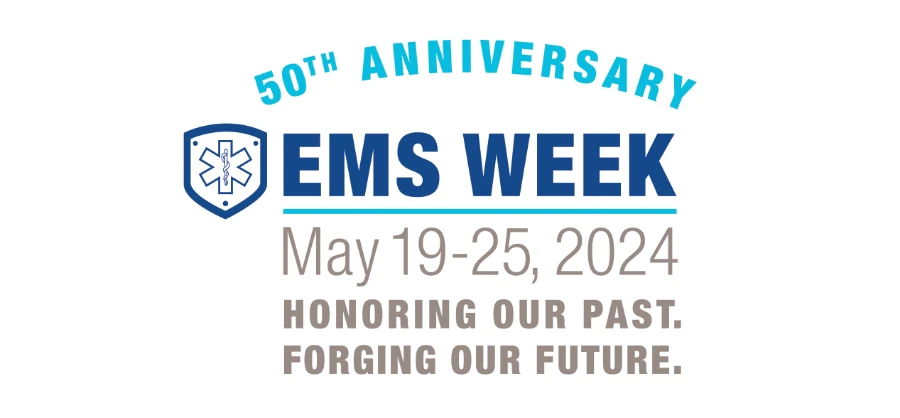In 2024, National EMS Week (May 19th to May 25th) reaches a significant milestone, celebrating half a century of commitment and service by EMS professionals. This landmark event not only honors past achievements but also anticipates the future of emergency medical services. This year’s theme, “Honoring Our Past, Forging Our Future,” aptly reflects this dual focus, providing a framework for both reflection and forward-thinking initiatives that highlight the evolution and impact of EMS services nationwide.
Historical Overview of EMS Week
Origins and Evolution
EMS Week started as a dedicated time to appreciate the critical role of emergency medical services in our healthcare system. Each year, it has adapted to meet the growing and changing needs of communities and the healthcare industry. The journey from its inception to now covers significant advancements in medical technology, training methodologies, and community integration. This retrospective will trace these key developments, showcasing how EMS Week has become a pivotal part of national health awareness efforts.
Past Themes and Their Impact
Over the decades, EMS Week has introduced themes that resonate deeply with community and professional needs. Themes like “EMS Strong” and “Ready Today, Preparing for Tomorrow” have underscored the resilience and proactive nature of EMS professionals. These themes have not only raised public awareness but have also driven improvements in EMS training and operations. This section will delve into how past themes have inspired EMS personnel to enhance their readiness and efficacy, significantly impacting community health outcomes.
Celebrating 50 Years of EMS
EMS Week 2024 Events and Activities
The 50th anniversary of EMS Week in 2024 is marked by a series of themed days, each designed to highlight crucial aspects of EMS work:
- Health, Wellness, and Resilience Day on Sunday focuses on the well-being of EMS personnel, promoting strategies for mental and physical health resilience.
- EMS Education Day on Monday emphasizes the importance of ongoing education and training for EMS professionals, showcasing advancements in EMS training techniques and technologies.
- Safety Tuesday highlights innovations in safety protocols that protect both EMS teams and the communities they serve.
- EMS for Children Day on Wednesday draws attention to pediatric emergency care, emphasizing the unique needs and care strategies for the youngest patients.
- Save-A-Life Day on Thursday encourages public participation in lifesaving techniques such as CPR and bleeding control, demonstrating the critical role of bystanders in emergency situations.
- EMS Recognition Day on Friday celebrates the dedication and achievements of EMS personnel with awards and public acknowledgment.
Special Initiatives and Announcements
This anniversary year will introduce several special initiatives and announcements that aim to enhance recognition and support for EMS personnel across the nation. New partnerships with healthcare organizations and community groups are slated to launch, enhancing the resources available to EMS professionals. These initiatives will also spotlight exceptional service through awards and national recognition, showcasing the crucial role of EMS workers in enhancing public health and safety.
The Role of EMS in Community Health
Case Studies and Success Stories
This segment will feature powerful stories from the field, where EMS teams have made a definitive impact on emergency outcomes. For instance, a detailed account may cover a multi-vehicle accident scene where EMS personnel efficiently triaged and treated dozens of patients, dramatically improving survival rates. These stories not only highlight the skills and dedication of EMS workers but also help the public understand the complex nature of emergency medical response.
Partnerships and Collaborations
Effective EMS response often involves collaboration with other health organizations and community resources. This section will explore successful examples of such partnerships, like joint operations between EMS and fire services during large-scale emergencies or integrated health services during public health crises. These collaborations not only improve immediate responses but also strengthen community resilience against future emergencies.
The Future of EMS
Innovations and Technological Advancements
Looking ahead, the future of EMS is intertwined with technological innovation. This part will explore cutting-edge developments such as telemedicine in ambulances, which allows paramedics to connect with hospital doctors in real-time, enhancing patient care en route to the hospital. Other innovations include the use of drones to deliver lifesaving equipment like AEDs to remote or inaccessible accident scenes, significantly reducing response times.
Challenges and Opportunities
Despite technological advances, EMS faces numerous challenges including funding limitations, workforce shortages, and the need for more specialized training. This section will discuss these challenges in detail, along with the opportunities they present for reform and innovation. For example, the integration of artificial intelligence in dispatch operations could optimize response times and resource allocation, marking a significant step forward for EMS systems nationwide.
Community and Educational Outreach
Community Engagement During EMS Week
Engagement from local communities significantly boosts the morale of EMS teams. During EMS Week, community groups can express their appreciation in various ways. Schools might create thank you cards or host assemblies to honor local EMS workers. Communities could also organize appreciation dinners. These events not only recognize EMS professionals but also educate the public about their critical roles in healthcare.
Educational Programs and Resources
EMS Week serves as a prime opportunity for public education about emergency medical services. Throughout the week, workshops and seminars are available, covering first aid, the importance of timely medical intervention, and how to effectively respond in emergencies. Schools can integrate these learning sessions into their curriculum, providing students with valuable life-saving skills. Libraries and community centers also play a part by hosting EMS professionals who share their experiences and knowledge.
Advocacy and Policy Impact
Legislative and Policy Changes
In recent years, legislative advancements have significantly influenced EMS operations. For instance, new laws regarding the rapid deployment of EMS personnel in rural areas have improved emergency response times. This section will delve into how such policies came to be and their impacts on both EMS services and community health. We will discuss the advocacy efforts that led to these changes, emphasizing the importance of informed policy-making in emergency medical services.
Role of EMS in Influencing Health Policy
EMS professionals frequently interact with systems that shape public health policies. Their on-the-ground experiences are invaluable for informing health safety protocols and emergency response strategies. For example, insights from EMS personnel have led to improved state guidelines on handling mass casualty incidents. This segment will explore various instances where EMS has directly influenced health policy, highlighting the critical role they play beyond immediate medical responses.
Final Thoughts
Reflecting on the past 50 years of National EMS Week reveals its crucial role in enhancing community health services. This celebration extends beyond honoring these heroes—it is about engaging with and supporting them into the future. As we look forward, let us continue to advocate for policies that support the growth and efficiency of EMS, ensuring they can always respond when needed most.
Frequently Asked Questions
In 2024, National EMS Week celebrates its significant 50-year milestone. This section addresses some frequently asked questions to deepen the understanding of EMS Week and its impact.
How can local businesses support EMS Week?
Local businesses can play a crucial role during EMS Week by sponsoring events or donating supplies that can be used in various EMS Week activities. For example, restaurants might offer meals for EMS workers, or printing companies could provide banners and educational materials for public events. Such support not only aids the events but also strengthens community ties with EMS services.
What are the common misconceptions about EMS professions?
One common misconception is that EMS workers only handle transportation for patients. In reality, EMS professionals provide critical pre-hospital care. They perform life-saving procedures and make crucial decisions about emergency care, which can be the difference between life and death.
How does EMS Week address the emotional well-being of EMS professionals?
EMS Week includes Health, Wellness, and Resilience Day, which focuses on the mental and physical health of EMS professionals. This day is dedicated to activities and seminars that promote coping strategies, stress management, and overall wellness. Programs might include mindfulness sessions, workshops on handling job-related stress, and discussions on mental health resources.
Are there specific programs for children during EMS Week?
Yes, EMS for Children Day is specifically designed to educate young people about emergency medical services. Schools and community centers often host events where children can learn about first aid and the roles of EMS professionals. Interactive activities like ambulance tours and meet-and-greets with paramedics aim to familiarize children with EMS tools and procedures, making them less intimidating in actual emergencies.
EMS Week 2024 Reference Links
To support research and provide a deeper understanding of the 50th anniversary of National EMS Week, here are five reputable sources, each with a brief description.
- National EMS Week 2024 – Celebrating 50 Years of EMS: Official site for EMS Week 2024, providing resources, history, and promotional materials.
- National EMS Week – NAEMT: This page by the National Association of Emergency Medical Technicians highlights the significance of EMS Week and its impact on healthcare providers.
- Celebrating 50 Years of EMS Week: A governmental perspective on the contributions of EMS professionals over the past 50 years, hosted by EMS.gov.
- Stories – EMS Week 2024: Features personal stories and reflections from EMS professionals, highlighting the human aspect of EMS services.
- EMS Week Store: Where EMS teams and supporters can find official EMS Week gear and promotional items for 2024.

Jeromy VanderMeulen is a seasoned fire service leader with over two decades of experience in emergency response, training, and public safety management. He currently serves as Battalion Chief at the Lehigh Acres Fire Control & Rescue District and is CEO of the Ricky Rescue Training Academy, a premier provider of online and blended EMT and firefighter certification programs in Florida.
Jeromy holds multiple degrees from Edison State College and the Community College of the Air Force, and is pursuing his MBA at Barry University. He maintains top-tier certifications, including Fire Officer IV, Fire Instructor III, and Fire Inspector II, and has served as a subject matter expert for a court case. He is a member or the Florida Fire Chiefs Association.
Jeromy also contributes to state-level fire safety regulation and serves on several hiring and promotional boards.

